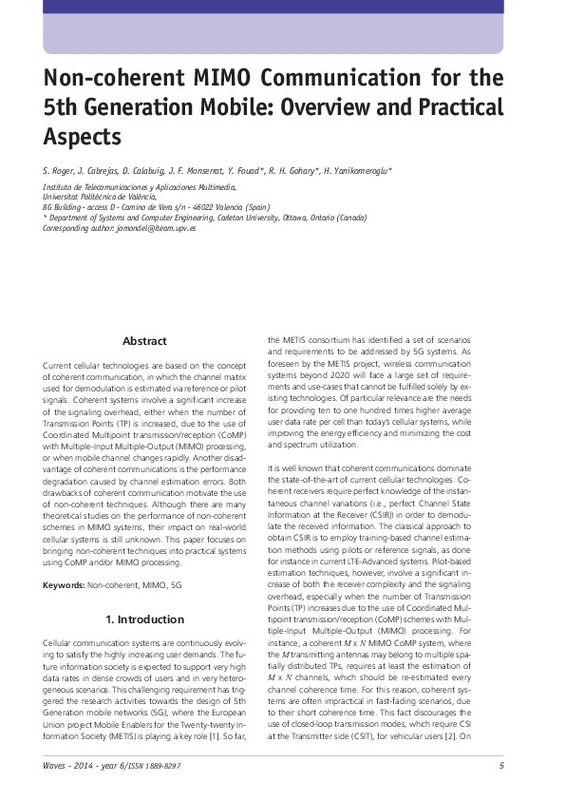JavaScript is disabled for your browser. Some features of this site may not work without it.
Buscar en RiuNet
Listar
Mi cuenta
Estadísticas
Ayuda RiuNet
Admin. UPV
Non-coherent MIMO Communication for the 5th Generation Mobile: Overview and Practical Aspects
Mostrar el registro sencillo del ítem
Ficheros en el ítem
| dc.contributor.author | Roger Varea, Sandra
|
es_ES |
| dc.contributor.author | Cabrejas Peñuelas, Jorge
|
es_ES |
| dc.contributor.author | Calabuig Soler, Daniel
|
es_ES |
| dc.contributor.author | Monserrat del Río, José Francisco
|
es_ES |
| dc.contributor.author | Fouad, Yaser
|
es_ES |
| dc.contributor.author | Gohary, Ramy H.
|
es_ES |
| dc.contributor.author | Yanikomeroglu, Halim
|
es_ES |
| dc.date.accessioned | 2015-07-09T18:10:30Z | |
| dc.date.available | 2015-07-09T18:10:30Z | |
| dc.date.issued | 2014 | |
| dc.identifier.issn | 1889-8297 | |
| dc.identifier.uri | http://hdl.handle.net/10251/52904 | |
| dc.description.abstract | [EN] Current cellular technologies are based on the concept of coherent communication, in which the channel matrix used for demodulation is estimated via reference or pilot signals. Coherent systems involve a significant increase of the signaling overhead, either when the number of Transmission Points (TP) is increased, due to the use of Coordinated Multipoint transmission/reception (CoMP) with Multiple-Input Multiple-Output (MIMO) processing, or when mobile channel changes rapidly. Another disadvantage of coherent communications is the performance degradation caused by channel estimation errors. Both drawbacks of coherent communication motivate the use of non-coherent techniques. Although there are many theoretical studies on the performance of non-coherent schemes in MIMO systems, their impact on real-world cellular systems is still unknown. This paper focuses on bringing non-coherent techniques into practical systems using CoMP and/or MIMO processing. | es_ES |
| dc.description.sponsorship | This work was performed in the framework of the FP7project ICT-317669 METIS, which is partly funded by the European Union. | es_ES |
| dc.language | Inglés | es_ES |
| dc.publisher | Instituto de Telecomunicaciones y Aplicaciones Multimedia (iTEAM) | es_ES |
| dc.relation.ispartof | Waves | es_ES |
| dc.rights | Reserva de todos los derechos | es_ES |
| dc.subject | Non-coherent | es_ES |
| dc.subject | MIMO | es_ES |
| dc.subject | 5G | es_ES |
| dc.subject.classification | TEORIA DE LA SEÑAL Y COMUNICACIONES | es_ES |
| dc.title | Non-coherent MIMO Communication for the 5th Generation Mobile: Overview and Practical Aspects | es_ES |
| dc.type | Artículo | es_ES |
| dc.relation.projectID | info:eu-repo/grantAgreement/EC/FP7/317669/EU/Mobile and wireless communications Enablers for Twenty-twenty (2020) Information Society/ | es_ES |
| dc.rights.accessRights | Abierto | es_ES |
| dc.contributor.affiliation | Universitat Politècnica de València. Instituto Universitario de Telecomunicación y Aplicaciones Multimedia - Institut Universitari de Telecomunicacions i Aplicacions Multimèdia | es_ES |
| dc.contributor.affiliation | Universitat Politècnica de València. Departamento de Comunicaciones - Departament de Comunicacions | es_ES |
| dc.description.bibliographicCitation | Roger Varea, S.; Cabrejas Peñuelas, J.; Calabuig Soler, D.; Monserrat Del Río, JF.; Fouad, Y.; Gohary, RH.; Yanikomeroglu, H. (2014). Non-coherent MIMO Communication for the 5th Generation Mobile: Overview and Practical Aspects. Waves. 6:5-15. http://hdl.handle.net/10251/52904 | es_ES |
| dc.description.accrualMethod | S | es_ES |
| dc.relation.publisherversion | http://www.iteam.upv.es/waves.php?id=7 | es_ES |
| dc.description.upvformatpinicio | 5 | es_ES |
| dc.description.upvformatpfin | 15 | es_ES |
| dc.type.version | info:eu-repo/semantics/publishedVersion | es_ES |
| dc.description.volume | 6 | es_ES |
| dc.relation.senia | 271705 | |
| dc.contributor.funder | European Commission |






